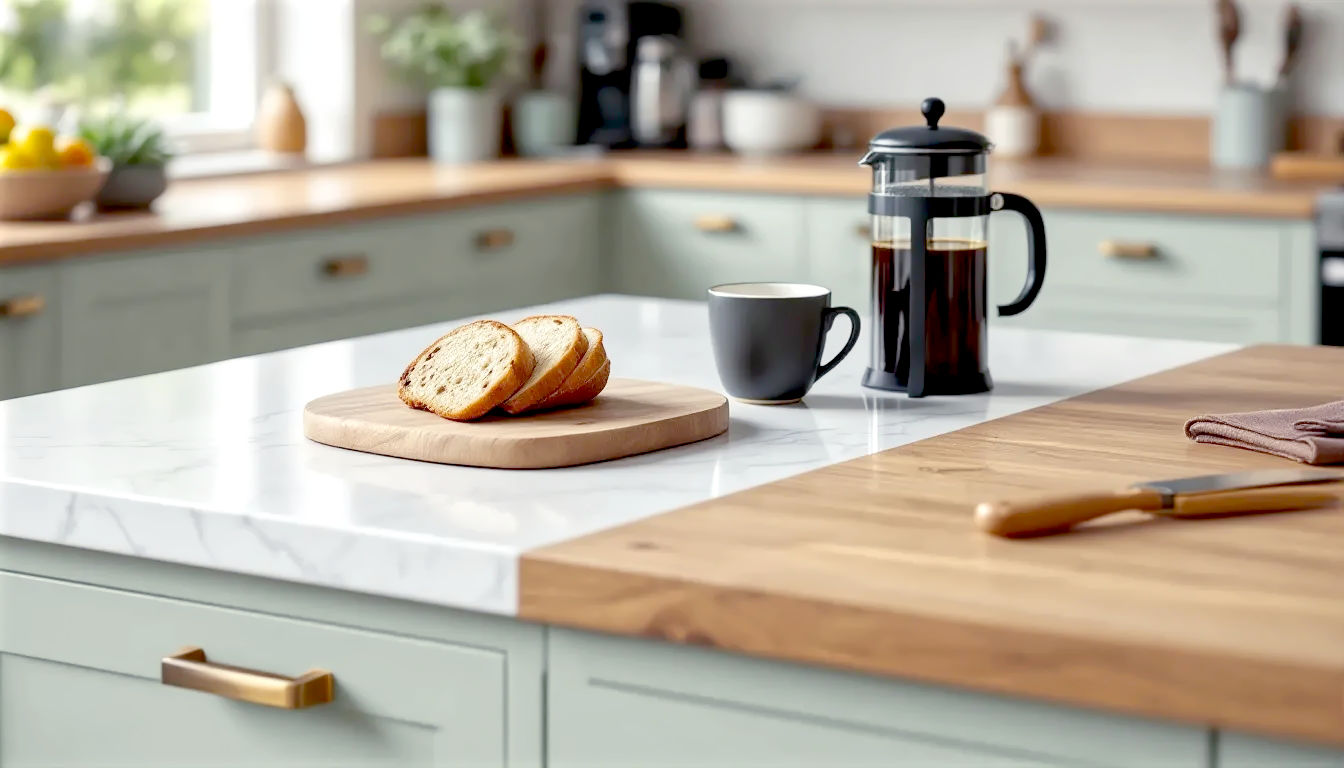From Laminate to Luxe: The Ultimate British Guide to Choosing Your Perfect Kitchen Worktop
Confused by kitchen worktops? Our ultimate UK guide breaks down every material, from budget laminate to luxury marble, helping you find the perfect fit.

This post may contain affiliate links. If you make a purchase through these links, we may earn a commission at no additional cost to you.
So, you’re redoing the kitchen. The cabinets are picked out, you’ve spent weeks deciding between a Belfast sink and a stainless steel one, and now it’s time for the crowning glory: the worktop. It’s a bigger deal than you might think. This isn’t just a slab of material to chop carrots on; it’s the workhorse of your kitchen. It’s where you’ll roll out pastry for the Sunday roast, where the kids will spill juice, where you’ll plonk down heavy shopping bags, and where you’ll lean while having a natter over a cuppa.
Choosing the right worktop can feel a bit like navigating a maze. There are so many options, from budget-friendly laminates that look surprisingly posh to jaw-droppingly beautiful natural stones that cost a pretty penny. And everyone’s got an opinion. Your mum swears by granite, your mate says solid wood is the only way to go, and that glossy magazine is showing off a kitchen with a concrete island that looks like something out of a sci-fi film.
Don’t you worry. We’re here to cut through the noise. This guide is your trusty map to the world of kitchen worktops. We’ll walk you through every option, breaking down what they are, how much they cost, what they’re like to live with, and who they’re best for. By the end, you’ll know your quartz from your Corian and feel confident you’re making the perfect choice for your home, your family, and your wallet. Let’s get stuck in.
The Foundation: Understanding Worktop Materials
Before we dive into the nitty-gritty of each type, let’s get a handle on the main families of worktop materials. They generally fall into a few camps:
- Laminates: The budget-friendly champion. Made from a chipboard core with a plastic laminate sheet bonded on top.
- Natural Stone: The real deal, quarried straight from the earth. This includes classics like granite and marble.
- Engineered Stone: Man-made slabs, usually made from crushed stone mixed with resin. Quartz is the most famous member of this family.
- Solid Wood: Exactly what it says on the tin. A timeless choice that brings natural warmth.
- Solid Surface Composites: Another man-made option, created from a blend of acrylic or polyester resins and minerals. Brands like Corian fall into this category.
- Metals & Industrial Materials: Think stainless steel, copper, or even concrete for a modern, edgy look.
Each one has its own personality, with unique strengths and weaknesses. The trick is finding the one that matches yours.
Laminate Worktops: The Smart & Stylish All-Rounder
Let’s start with the undisputed king of the budget-friendly kitchen: laminate. For years, laminate had a bit of an image problem. People pictured thin, plasticky surfaces with dodgy patterns that chipped if you looked at them too hard. But things have changed. A lot.
Modern laminate worktops are a world away from their predecessors. Thanks to high-definition printing and clever texturing, they can now mimic the look of expensive materials like granite, marble, and solid wood with uncanny accuracy. You can get finishes that feel like real stone or wood grain, making them a brilliant choice if you love the luxe look but not the luxe price tag.
What’s to Love About Laminate?
- It’s a Bargain: This is laminate’s superpower. It’s the most affordable worktop material by a country mile. For a standard kitchen, you could be looking at a few hundred pounds, whereas some stone options would run into the thousands.
- Endless Designs: Seriously, endless. Whether you want a worktop that looks like rare Italian Calacatta marble, rustic oak, or sparkly quartz, there’s a laminate for you. You can even get bold colours and funky patterns.
- Easy to Clean: The non-porous plastic surface is a doddle to look after. A simple wipe with a damp cloth and a bit of washing-up liquid is all it needs. It’s resistant to most stains, so you don’t need to panic about spilt red wine or curry.
- Simple to Install: Laminate is lightweight and easy to cut, which means a confident DIYer can often fit it themselves, saving even more money on installation costs.
What are the Downsides?
- Not Heatproof: This is the big one. You cannot put hot pans directly onto a laminate worktop. The heat will melt the plastic coating, leaving a permanent scorch mark. Always, always use a trivet.
- Prone to Scratches: While modern laminates are tougher than they used to be, they can still be scratched by sharp knives. Always use a chopping board. Deeper scratches are impossible to repair.
- Water Can Be an Enemy: The top surface is waterproof, but the chipboard core is not. If water gets into the joints (especially around the sink) or a chip in the surface, the chipboard can swell and blow, ruining the worktop. It’s crucial that joints are sealed perfectly during installation.
- It’s Not the Real Thing: As good as the imitations are, at the end of the day, laminate doesn’t have the cold, solid feel of stone or the natural character of wood.
The Verdict: Laminate is a fantastic choice for anyone on a tight budget, for first-time homeowners, or for rental properties. It offers incredible style for its price, but you need to be mindful of its vulnerabilities to heat and scratches.
- Typical Cost: £20 – £50 per square metre (supply only)
Solid Wood Worktops: The Warm & Rustic Classic
There’s something undeniably cosy and inviting about a wooden worktop. It brings a natural warmth and character to a kitchen that man-made materials struggle to replicate. From the pale, clean lines of maple to the rich, dark tones of walnut, a wooden worktop can suit everything from a rustic farmhouse kitchen to a sleek, modern space.
But owning a wooden worktop is a bit like having a pet. It needs regular care and attention to keep it looking its best. This is a material you have to be prepared to look after.
What’s Great About Solid Wood?
- Stunning Natural Beauty: Each piece of wood is unique, with its own grain and character. It adds a softness and warmth that can make a kitchen feel instantly more homely.
- It Gets Better with Age: While some materials show their wear and tear, a well-maintained wooden worktop develops a rich patina over time, adding to its character.
- Repairable: This is a huge advantage. Unlike laminate or stone, which can be difficult or impossible to repair, scratches and minor scorch marks on a wooden worktop can be sanded out and re-oiled, making it look as good as new.
- Naturally Antibacterial: Studies have shown that wood has natural properties that kill bacteria, making it a surprisingly hygienic choice.
What are the Challenges?
- High Maintenance: This is the deal-breaker for many. Wooden worktops need to be oiled regularly (at least twice a year, and more often when new) to protect them from water and stains. If you don’t keep up with this, the wood can dry out, stain, or even start to warp and split.
- Vulnerable to Water Damage: You have to be vigilant about wiping up spills immediately. Standing water is the enemy. The area around the sink is particularly vulnerable, and if not properly sealed and maintained, it can turn black with mould and begin to rot.
- Can Dent and Scratch: Wood is softer than stone or quartz. It will pick up scratches and dents from everyday use. While some see this as part of its charm (a developing ‘character’), others will find it frustrating.
- Can Stain: Strong-coloured foods like beetroot, red wine, and turmeric can stain the wood if not wiped up quickly.
The Verdict: A solid wood worktop is for someone who loves natural materials and is happy to put in the effort to maintain them. If you’re a keen cook who enjoys the ritual of caring for your kitchen, it can be a rewarding and beautiful choice that lasts a lifetime. If you’re after a low-maintenance, fit-and-forget option, look elsewhere.
- Popular Wood Choices: Oak, Beech, Walnut, Maple, Bamboo (technically a grass, but treated as a wood).
- Typical Cost: £100 – £250 per square metre (supply only)
Granite Worktops: The Timeless Natural Powerhouse
For decades, granite has been the go-to choice for a high-end kitchen. Quarried from huge blocks of stone all over the world, each slab of granite is a unique piece of natural art, millions of years in the making. It’s tough, beautiful, and adds a real sense of quality and permanence to a kitchen.
Granite comes in a vast range of colours and patterns, from consistent speckled greys and blacks to wildly dramatic swirls of reds, blues, and greens. Visiting a stone yard to pick out your exact slab is part of the experience.
Why Do People Love Granite?
- Incredibly Durable: Granite is one of the hardest natural materials on earth. It’s very difficult to scratch – you’re more likely to blunt your knives on it than damage the surface.
- Heat Resistant: You can take a hot pan straight from the oven and place it on a granite worktop without any fear of scorching or melting it. This is a massive plus for keen cooks.
- Each Slab is Unique: No two granite worktops are ever identical. The unique patterns, veins, and mineral flecks mean your kitchen will be one-of-a-kind.
- Adds Value: A granite worktop is seen as a premium feature and can add to the resale value of your home.
What Should You Be Aware Of?
- It’s Porous (ish): Granite is a natural stone, which means it has tiny pores. If unsealed, it can absorb liquids, leading to stains. Most granite worktops are sealed upon installation, and this sealant needs to be re-applied every year or two to keep it protected. It’s a simple job you can do yourself.
- Can Be Stained by Strong Spills: Even when sealed, it’s wise to quickly clean up spills like red wine, oil, and citrus juice, as they can sometimes penetrate the stone if left for a long time.
- It Can Chip or Crack: While granite is incredibly tough, a heavy impact from something like a cast-iron pan dropped on an edge or corner can cause a chip or, in very rare cases, a crack. Repairs can be done by specialists but can be costly and may remain visible.
- It’s Expensive: Granite is a premium material, and its price reflects that. The cost includes not just the stone but also the professional templating and installation, which is not a DIY job.
The Verdict: Granite is a brilliant investment for a “forever” kitchen. It’s a beautiful, durable, and practical work surface that can handle the heat of a busy family kitchen. You just need to be prepared for the initial cost and the minimal upkeep of resealing it periodically.
- Typical Cost: £250 – £500+ per square metre (including templating and installation)
Quartz Worktops: The Engineered Stone Superstar
If granite is the classic natural choice, quartz is its modern, engineered rival. And it’s winning a lot of fans. Quartz worktops aren’t pure, natural slabs. Instead, they are manufactured from around 90-95% crushed natural quartz (one of nature’s hardest minerals) mixed with polymer resins and pigments. This mixture is compacted into slabs under intense pressure and heat.
The result is a material that has the look and feel of natural stone but with some added superpowers. Because it’s man-made, the patterns and colours are consistent, which many people prefer over the unpredictability of granite. You can get quartz that looks just like marble but without the maintenance headaches, as well as bright, solid colours that you’d never find in nature.
What are the Big Advantages of Quartz?
- Completely Non-Porous: The resins used in its construction fill all the gaps, making the surface totally sealed. This means it never needs sealing and is completely resistant to stains. It’s one of the most hygienic surfaces you can get.
- Extremely Hard-Wearing: Like granite, quartz is incredibly hard and resistant to scratches and chips. It can handle the rough and tumble of family life with ease.
- Consistent Appearance: If you need multiple pieces of worktop for a large kitchen, you can be sure they will all match perfectly. The colour and pattern you see in the showroom is exactly what you’ll get.
- Huge Range of Styles: From minimalist whites and greys to bold blues and sparkly blacks, the design possibilities are vast. Brands like Silestone and Caesarstone are constantly bringing out new designs that mimic the latest natural stone trends.
Are There Any Downsides?
- Not as Heat Resistant as Granite: This is the main difference. The resins in quartz can be damaged by extreme heat. While it can handle a warm plate, you should not put a searing hot pan directly on the surface. Always use a trivet, just as you would with laminate.
- The Price Tag: Quartz sits in the same premium price bracket as granite. It’s a significant investment.
- Can Be Damaged by Sunlight: Some of the cheaper quartz worktops, or those with certain pigments, can discolour over time if exposed to direct sunlight for long periods. This is something to consider if you have a very sunny kitchen or are planning an outdoor kitchen.
- Not a ‘Natural’ Product: For stone purists, the fact that it’s an engineered product can be a turn-off. It lacks the unique geological history of a slab of granite or marble.
The Verdict: Quartz is the perfect choice for someone who wants the premium look and durability of stone but with zero maintenance. It’s ideal for busy families who need a beautiful but bomb-proof surface that they don’t have to worry about staining or sealing.
- Typical Cost: £300 – £600+ per square metre (including templating and installation)
Marble Worktops: The Utterly Beautiful Diva
Let’s be honest: nothing looks quite as luxurious as a marble worktop. Its soft, milky appearance and distinctive, elegant veining have made it a symbol of high-end design for centuries. It’s the stuff of dream kitchens you see on Pinterest and in glossy magazines.
However, marble is the diva of the worktop world. It’s stunningly beautiful, but it’s also high-maintenance, demanding, and unforgiving. It’s a choice you make with your heart, not necessarily your head.
Why Fall in Love with Marble?
- Unrivalled Beauty: The soft, luminous quality of marble is unique. It has a depth and elegance that other materials can only try to imitate.
- Stays Cool: Marble is a naturally cool stone, which is why it’s traditionally prized by bakers and pastry chefs for rolling out dough.
- Develops a Unique Patina: Marble enthusiasts don’t see its flaws as damage. They see the stains, scratches, and etches that accumulate over time as part of the stone’s story, creating a patina that is unique to their home, much like an old French bistro table.
What Are the Hard Truths About Marble?
- It Stains. Easily: Marble is much softer and more porous than granite. Spilling red wine, coffee, or even just water and leaving it can result in a permanent stain. It needs to be sealed regularly, but even then, it’s not foolproof.
- It Scratches and Etches: It’s a relatively soft stone, so it will scratch. More importantly, it’s a calcium carbonate, which means it reacts with acids. Anything acidic – lemon juice, vinegar, tomatoes – will eat away at the surface, leaving a dull, whitish mark called an etch. This isn’t a stain; it’s a physical change to the stone’s surface.
- It’s Expensive and Fragile: Not only is it one of the most expensive worktop options, but it’s also more prone to chipping and cracking than granite or quartz, especially around the sink and edges.
The Verdict: Marble is for the purist who values beauty above all else and is willing to accept – and even embrace – its imperfections. It is not for a busy, low-maintenance family kitchen. If you’re a meticulous cook who cleans up immediately and sees the marks of use as character, then its beauty might be worth the effort. For most people, a marble-effect quartz is a much more practical choice.
- Typical Cost: £400 – £700+ per square metre (including templating and installation)
Other Materials Worth Considering
While the big five—laminate, wood, granite, quartz, and marble—cover most kitchens, there are other exciting materials out there for those who want something a bit different.
Solid Surface (e.g., Corian, Minerva)
Solid surface worktops are made from a blend of acrylic resins, minerals, and pigments. The result is a smooth, silky-feeling material that can be moulded into virtually any shape.
- Pros: The biggest selling point is seamless joints. Pieces can be glued together and sanded so the join is completely invisible. This also allows for integrated sinks made from the same material, creating a super-sleek, modern look. It’s non-porous, hygienic, and can be repaired if scratched by sanding the surface.
- Cons: It’s not as heat-resistant as stone (use trivets!) and it can scratch more easily than quartz, though scratches are repairable. It sits in the mid-to-high price range.
- Best for: People who want a seamless, modern, and hygienic kitchen with flowing curves and integrated sinks.
- Typical Cost: £250 – £450 per square metre
Stainless Steel
Once confined to professional restaurant kitchens, stainless steel has become a popular choice for a contemporary, industrial look at home.
- Pros: It’s completely heatproof, waterproof, and hygienic. You can’t stain it, and it’s easy to clean (though it does show fingerprints!).
- Cons: It scratches. A lot. From day one, it will pick up fine scratches that eventually merge into a sort of matt patina. If you want a pristine, shiny surface forever, this isn’t for you. It can also be quite noisy when you put pans and plates down on it.
- Best for: A serious home cook who loves the professional kitchen aesthetic and isn’t precious about a few scratches.
- Typical Cost: £200 – £400 per square metre
Concrete
For a raw, urban, and industrial vibe, nothing beats concrete. Each worktop is custom-made, often poured on-site or created from a template.
- Pros: It’s incredibly strong and heat-resistant. You can have it made in any shape or thickness, and you can even embed things in it, like drainer grooves or decorative objects.
- Cons: It’s extremely heavy, so your kitchen units must be strong enough to support it. Like granite, it’s porous, so it absolutely must be sealed properly and regularly to prevent staining. It can also develop fine hairline cracks over time, which some see as part of its industrial charm. It’s a specialist, expensive option.
- Best for: Someone creating a unique, design-led space with a strong industrial or minimalist feel.
- Typical Cost: £500 – £800+ per square metre
Making the Final Decision: What’s Right For You?
Choosing the best worktop isn’t about finding the “best” material overall, but the best material for your lifestyle, your budget, and your style. Here’s a quick checklist of questions to ask yourself:
- What’s my honest budget? Be realistic. Remember to factor in the cost of templating, delivery, and installation, which can add a significant amount, especially for stone and other specialist materials.
- How much maintenance am I really prepared to do? Be honest with yourself. If you’re the kind of person who leaves spills until the morning, then a high-maintenance material like wood or marble will be a constant source of stress. If you want to just wipe and go, quartz or laminate is your friend.
- How do I use my kitchen? Are you a keen baker who needs a cool surface? A busy parent who needs something bomb-proof? A clumsy cook who is likely to drop heavy pans? Or someone who mainly uses the microwave? Your daily habits will determine whether you need extreme durability and heat resistance.
- What’s my style? Are you aiming for a warm, traditional farmhouse look? A sleek, minimalist modern vibe? Or a grand, luxurious space? The material you choose will have a huge impact on the overall feel of your kitchen.
Here’s a final cheat sheet to help you decide:
| Material | Best for… | Watch out for… |
|---|---|---|
| Laminate | Tight budgets, stylish looks for less, DIY install. | Heat, scratches, water in joints. |
| Solid Wood | Natural warmth, character, a traditional feel. | High maintenance, water damage, scratches. |
| Granite | Durability, heat resistance, natural beauty. | Needs sealing, can chip, high cost. |
| Quartz | Zero maintenance, stain-proof, modern looks. | Not fully heatproof, high cost. |
| Marble | Ultimate luxury, baking, embracing character. | Stains, scratches, and etches easily. |
| Solid Surface | Seamless look, integrated sinks, modern curves. | Scratches (but repairable), not heatproof. |
Take your time, get samples, and see how they look in your kitchen’s light. A worktop is a long-term relationship, so make sure you choose one you’ll be happy to live with for years to come.
Further Reading
To continue your research with trusted sources, we recommend visiting these highly-respected websites:
- Which? Kitchen Worktop Guide: Known for their independent and rigorous product testing, Which? offers expert guides on the pros and cons of different worktop materials.
- Houzz UK: An excellent resource for design inspiration, with thousands of photos of British kitchens. You can see how different worktops look in real homes and connect with local designers and installers.
- Homebuilding & Renovating: A brilliant magazine and website for anyone undertaking a home improvement project in the UK, with in-depth articles on materials and budgeting.
- The Kitchen Think: An informational site backed by the industry, offering practical advice and guides on all aspects of kitchen planning.






